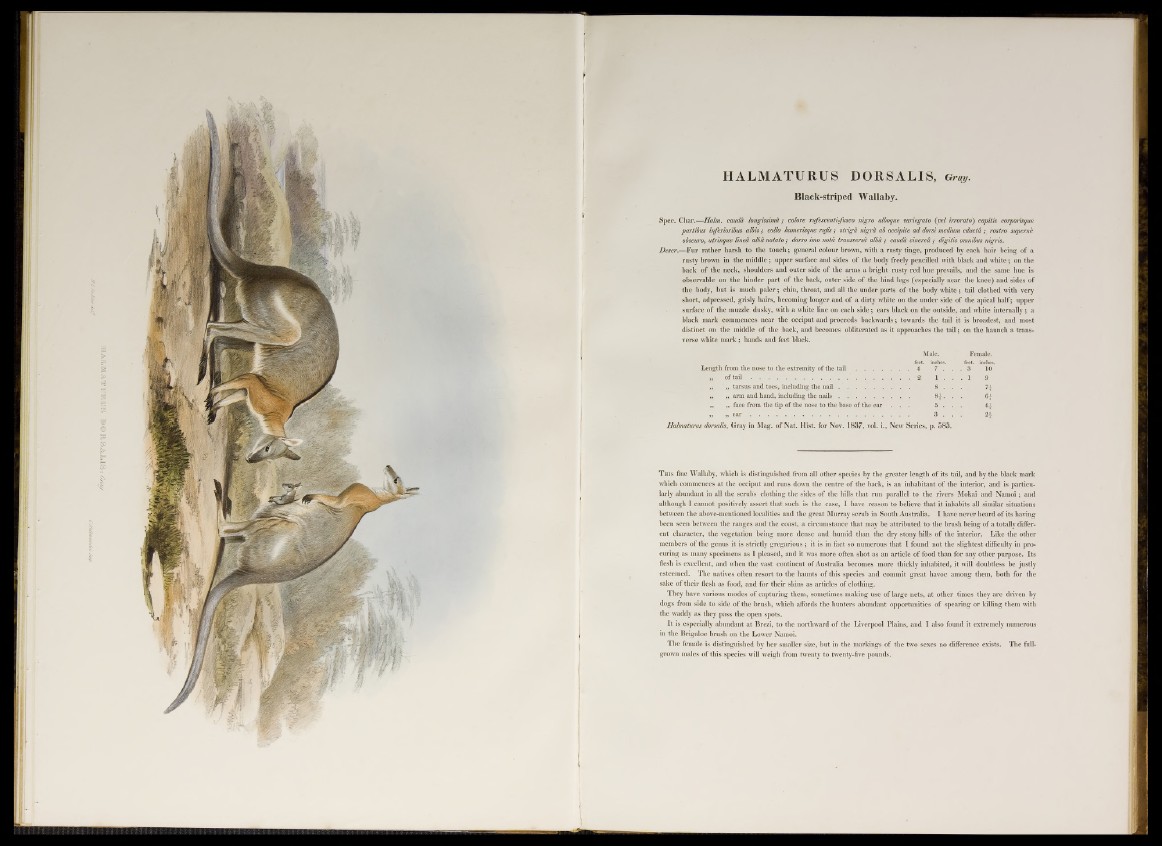
HALMATURUS DORSALIS, Gray.
Black-striped Wallaby.
Spec. Char.— Halm, cauda longissima; colore rufescenti-fusco nigro alboque variegato (cel irrorato) capitis corporisque
partibus inferioribus albis; collo humerisque rufis; striga nigra ab occipite ad dorsi medium educta rostro superne
obscuro, utrinque lined alba notato ; dorso imo notd transversd alba ; cauda cinerea ,• digit is omnibus nigris.
Descr.—Fur rather harsh to the touch; general colour brown, with a rusty tinge, produced by each hair being o f a
rusty brown in the middle ; upper surface and sides o f the body freely pencilled with black and white; on the
back o f the neck, shoulders and outer side o f the arms a bright rusty red hue prevails, and the same hue is
observable on the hinder part o f the back, outer side o f the hind legs (especially near the knee) and sides of
the body, but is much paler; chin, throat, and all the under parts o f the body white; tail clothed with very
short, adpressed, grisly hairs, becoming longer and o f a dirty white on the under side o f the apical half; upper
surface o f the muzzle dusky, with a white line on each sid e; ears black on the outside, and white internally; a
black mark commences near the occiput and proceeds backwards; towards the tail it is broadest, and most
distinct on the middle o f the back, and becomes obliterated as it approaches the tail; on the haunch a transverse
white mark; hands and feet black.
Male. Female.
feet, inches. feet, inches.
Length from the nose to the extremity o f the t a i l ....................... . . 4 7 . . . 3 10
„ o f t a i l ............................................................................................. . 1 9
| P P k%;, tarsus and toes, including the n a i l ................................... 8 . . H
,, „ arm and hand, including the n a i l s ................................... ¡g j . n
,, ,, face from the tip o f the nose to the base o f the ear 5 . 4£
,, „ e a r ............................................................................................. . . 3 . . 2 f
Halmaturus dorsalis, Gray in Mag. o f Nat. Hist, for Nov. 1837, vol. i., New Series, p. 583.
T his fine Wallaby, which is distinguished from all other species by the greater length o f its tail, and by the black mark
which commences at the occiput and runs down the centre of the back, is an inhabitant o f the interior, and is particularly
abundant in all the scrubs clothing the sides o f the hills that run parallel to the rivers Mokai and Namoi; and
although I cannot positively assert that such is the case, I have reason to believe that it inhabits all similar situations
between the above-mentioned localities and the great Murray scrub in South Australia. I have never heard o f its having
been seen between the ranges and the coast, a circumstance that may be attributed to the brush being o f a totally different
character, the vegetation being more dense aud humid than the dry stony hills o f the interior. Like the other
members o f the genus it is strictly gregarious ; it is in fact so numerous that I found not the slightest difficulty in procuring
as many specimens as I pleased, and it was more often shot as an article o f food than for any other purpose. Its
flesh is excellent, and when the vast continent o f Australia becomes more thickly inhabited, it will doubtless be justly
esteemed. The natives often resort to the haunts o f this species and commit great havoc among them, both for the
sake o f their flesh as food, and for their skins as articles o f clothing.
They have various modes o f capturing them, sometimes making use o f large nets, at other times they are driven by
dogs from side to side o f the brush, which affords the hunters abundant opportunities o f spearing or killing them with
the waddy as they pass the open spots.
It is especially abundant at Brezi, to the northward o f the Liverpool Plains, and I also found it extremely numerous
in the Brigaloe brush on the Lower Namoi.
The female is distinguished by her smaller size, but in the markings o f the two sexes no difference exists. The full-
grown males o f this species will weigh from twenty to twenty-five pounds.